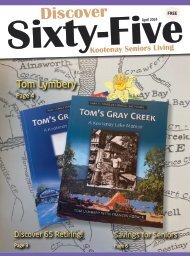June 14, Pennywise – Trail, Beaver Valley, Rossland
Complete coverage of Trail, Rossland, Fruitvale, Montrose.
Complete coverage of Trail, Rossland, Fruitvale, Montrose.
You also want an ePaper? Increase the reach of your titles
YUMPU automatically turns print PDFs into web optimized ePapers that Google loves.
The Big Bad Wolf: How Big and How Bad? Written by Ken Sumanik<br />
How big? As big as a big German Sheppard<br />
dog, although males can exceed 100 pounds<br />
(45.5 kilos) but they are generally about 70 or<br />
80 pounds (31.2 to 36.3 kilos), How bad? Their<br />
evil is legendary, based on historical accounts<br />
of killing humans, and ravaging their livestock,<br />
and therefore reason enough to use whatever<br />
means to cull them. Wolves and Brown bears<br />
were eradicated centuries ago in the British<br />
Isles and other western Old-World countries.<br />
The absence of both species enabled livestock<br />
and deer production that continues to this day<br />
in the British Isles. However, European Union<br />
member countries have to comply with an<br />
obligation in 1995 to reinstate their wolf and<br />
bear populations. Ecosystem restoration to<br />
maintain biodiversity was the rationale for this<br />
change in game management policy that is<br />
failing to achieve expectations. Wolves have<br />
dispersed across Europe preying on livestock,<br />
wild ungulates and even family pets, but more<br />
ominously are hybridizing which is sure to result<br />
in a different wolf.<br />
Wolves were eradicated by the mid 1950s in the<br />
New World, USA except for Alaska and most of<br />
Canada. A reversal began when wolves were<br />
legally protected in the USA by the Endangered<br />
Species Act (ESA) in1973. The results are equally<br />
devastating on people whose livelihoods are<br />
dependent on wild and domestic ungulates.<br />
Ecosystem restoration to maintain biodiversity<br />
was the same rationale used by the USF&WS<br />
in 1995 to transplant Canadian wolves into Yellowstone<br />
National Park (YNP) that subsequently<br />
decimated ungulate populations, particularly<br />
and elk. Wolves dispersed beyond the park<br />
boundary onto private lands to prey on livestock<br />
and game animals, mainly elk, deer and<br />
moose impacting the livelihoods of ranchers,<br />
farmers and outfitters.<br />
That it has taken four decades to realize the<br />
profoundly negative impact of wolf predation<br />
based on centuries of experience is astounding.<br />
The following are examples of where deer and<br />
moose abundance is maintained in an absence<br />
of wolves, by effective management of black<br />
bears and coyotes that are the only predators.<br />
Anticosti Island , Quebec<br />
The island is a very sparsely inhabited situated in<br />
the Gulf of St. Lawrence. It is about 7,892 square<br />
kms or 3047 Services square miles that is physiographically<br />
similar to the rest of the region. Indigenous<br />
wildlife were eradicated by 1890 but upon acquisition<br />
in 1895 by Henri Menier, a keen hunter<br />
who stocked it with 220 white-tailed deer. Presently<br />
there are approximately 120,000, whitetails,<br />
20 per sq. Km, down from a high about<br />
160,000, and 1000 moose. Hunting is managed<br />
by Sépaq, a Quebec government agency.<br />
Newfoundland (Island)<br />
The island was a British Colony until 1949 when<br />
it joined the Canadian Confederation. It is<br />
108,860 sq. Kms, typically boreal forest with a<br />
human population of about 550,000. Its moose<br />
population of about 110,000 animals is estimated<br />
at 1.1 per sq. Km, down from a previous high<br />
of about <strong>14</strong>0,000, thirty years ago. Moose were<br />
introduced to the island in the early 1900s, from<br />
a source in New Brunswick to establish guided<br />
hunting as an industry that succeeded but also<br />
became a significant sustenance resource. The<br />
government boasts, “A license for every two<br />
moose”! Approximately 70,000 licenses are sold,<br />
and 19,000 moose harvested annually. Heavy<br />
browsing by moose has impacted the forests<br />
in Gros Morne and Bonavista National Parks so<br />
forest restoration is being done by reducing<br />
their numbers in both parks. A woodland caribou<br />
population of approximately 16,000 is also<br />
hunted. Black bears exist and prey on caribou<br />
and moose but the threat to both species is<br />
reduced as bears are also hunted. Wolves don’t<br />
exist on the island but a fear of them crossing a<br />
possible frozen Strait of Belle Isle from Labrador<br />
to the island is a concern.<br />
Cape Breton Island (CBI, Nova Scotia)<br />
The island is 10,311 sq. Kms situated at the<br />
northeastern tip of Nova Scotia. It is connected<br />
to the province by a causeway that crosses<br />
the Canso Strait. Indigenous wolf and moose<br />
populations were eradicated in the late 1890s.<br />
An introduction of 18 moose from Elk Island National<br />
Park, Alberta in 1947- 48 established a viable<br />
population. A spruce budworm infestation<br />
during the 1970s was beneficial to the moose<br />
population, and as predation was minimal, it increased<br />
to approximately 5000 animals by 2010.<br />
Over browsing the forest of Cape Breton Island<br />
National Park (CBINP) required reducing moose<br />
numbers, as in NL National Parks. A moose<br />
population survey by Parks Canada in 2015<br />
recorded 1800 animals, approximately two per<br />
sq. Km. A repeat survey in 2019 recorded only<br />
481 animals. 2019. The survey data confirms that<br />
a serious decrease in the CBI moose population<br />
has occurred over the five year period.<br />
Summary<br />
Residents of these three widely separated<br />
islands in Eastern Canada continue to benefit<br />
from abundant moose<br />
and deer populations, the<br />
result of introductions<br />
attempted during the<br />
early Services 1900s. Their purpose<br />
was to produce game<br />
populations as a source of<br />
sustenance and revenue.<br />
The species adapted and<br />
thrived. Foxes, black bears<br />
and coyotes also exist on<br />
several of the islands and<br />
are not considered serious<br />
threats to ungulate survival<br />
for they are also hunted<br />
and trapped. Hunting<br />
is the primary source of<br />
Services<br />
ungulate mortality, regulated<br />
by governments<br />
intent on maintaining<br />
high levels of game production expected of a<br />
discerning hunting public, density independent<br />
factors notwithstanding. Should game<br />
populations decline to unsatisfactory levels,<br />
governments and their regulators will be held<br />
to account, not foxes, coyotes and black bears.<br />
The remarkable success of the deer and moose<br />
introductions to these islands coincident with<br />
an absence of wolves, has exceed expectations.<br />
Habitat was not a limiting factor.<br />
Impacts of Wolf Predation on Prey and People<br />
Wolves were eradicated from the US lower forty-eight<br />
by 1955 to enable livestock and game<br />
production to sustain our unique western way<br />
of life. The impact of the other major predators,<br />
cougars, grizzly and black bears and coyotes<br />
was managed by a combination of regulated<br />
hunting, trapping and bounties as required<br />
to produce abundant game populations as a<br />
source of food, and to maintain our hunting<br />
heritage. The use of fur, fish and game species<br />
in perpetuity required controlling predators<br />
for that purpose. This NAGM model was used<br />
successfully for five decades but is seriously<br />
threatened as human needs are increasingly<br />
subordinated to ecosystem related interests.<br />
State game managers had to comply with the<br />
wolf protection policy under the ESA. This was<br />
a serious impediment to game management<br />
practices that resulted in severe decimations<br />
caused by wolf predation. Provincial agencies<br />
accommodated similar wolf predation policy<br />
constraints that resulted in significant decreases<br />
in moose, elk and deer populations, and the<br />
near demise of caribou populations nationwide,<br />
except for NL (Island).<br />
Efforts to restore game populations are just<br />
beginning in several States where wolves have<br />
been delisted; ID, MT, WY and WI. Recently the<br />
Government of Idaho proclaimed a cull of 90<br />
per cent of the wolves based on factual information<br />
of severe wolf predation. The following<br />
link records Idaho elk population collapse that<br />
compares with elk in the East Kootenay in BC<br />
and adjoining US States. (see link #1)<br />
Services<br />
Link 1: https://www.youtube.com/<br />
watch?v=eqpr0xoTp9E<br />
Similarly, Montana and Wyoming state governments<br />
recently committed to reducing their<br />
wolf populations. (See link #2 as Montana steps<br />
up)<br />
Link #2: https://www.boisestatepublicradio.<br />
org/post/montana-governor-given-written-warning-after-trapping-killing-yellowstone-wolf#stream/0<br />
Wolves are hunted and trapped in BC, but<br />
recently subjected to culling by government in<br />
specific areas under a Primary Predator Reduction<br />
Program as a woodland caribou population<br />
recovery measure. Objectors to the culling were<br />
anticipated. (See link #3)<br />
Link #3: https://www.nationalobserver.<br />
com/2021/05/03/news/bc-kills-237-wolveswhile-court-case-pending<br />
The North West Territory government is also<br />
considering a wolf cull program to restore caribou<br />
populations.<br />
Wolves are also a major factor in the drastic decrease<br />
in BC moose populations that was finally<br />
acknowledged by the government. Recommendations<br />
for restoration were provided by a<br />
consultant on July 5, 2016. (See link #4)<br />
Link #4: www.env.gov.bc.ca/fw/wildlife/management-issues/docs/Restoring-and-Enhancing-Moose-Populations-in-BC-July-8-2016.pdf<br />
Deteriorations of the NAGM model are available<br />
on government and hunter-maintained websites,<br />
as reports and commentaries. (See link #5)<br />
Link #5: https://idahoforwildlife.com/files/pdf/<br />
georgeDovel/The%20Outdoorsman%20No%20<br />
30%20Aug-Sept%202008%20The%20Truth%20<br />
about%20Our%20Wildlife%20Managers.pdf<br />
Ponderations?<br />
Can a wolf be bad…or good? This is a rhetorical<br />
question because a wolf cannot be held to<br />
any moral standard for pursuing and killing its<br />
prey. The logical answer must be, neither good<br />
nor bad, even if the prey is a human. However,<br />
outcomes of wolf behaviors that are harmful to<br />
humans must be addressed empirically.<br />
Services<br />
Submitted by Carmen C. Purdy<br />
President KWHF<br />
Director Emeritus The Nature Trust<br />
Past President the BC Wildlife Federation<br />
Past Chair the BC Conservation Foundation<br />
Founding director The Habitat Conservation Fund<br />
Sponsored Content<br />
Thanks for your support!<br />
8 <strong>June</strong> <strong>14</strong>, 2021 <strong>Pennywise</strong> Publishing every 2nd week N picture online: www.pennywiseads.com


















